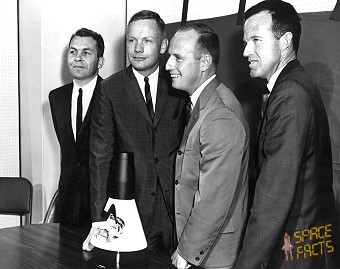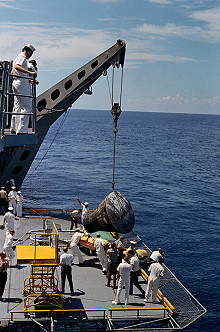Human Spaceflights
![]()
International Flight No. 15Gemini 5USA |
 |
 |
![]()
Launch, orbit and landing data
walkout photo |
 |
||||||||||||||||||
alternative crew photo |
|||||||||||||||||||
alternative crew photo |
Crew
| No. | Surname | Given names | Position | Flight No. | Duration | Orbits | |
| 1 | Cooper | Leroy Gordon, Jr. "Gordo" | Command Pilot | 2 | 7d 22h 55m 14s | 120 | |
| 2 | Conrad | Charles, Jr. "Pete" | PLT | 1 | 7d 22h 55m 14s | 120 |
Crew seating arrangement
|
 |
Backup Crew
|
 |
Hardware
| Launch vehicle: | Titan II GLV No. GT-5 (62-12560) |
| Spacecraft: | Gemini 5 (S/C-5 No. 2326) |
Flight
|
Launch from Cape Canaveral and landing 620 km
southwest of the Bermuda Islands in the Atlantic Ocean. The Gemini spacecraft was a cone-shaped capsule consisting of two components, a reentry module and an adaptor module. The adaptor module made up the base of the spacecraft. It was a truncated cone 228.6 cm high, 304.8 cm in diameter at the base and 228.6 cm at the upper end where it attached to the base of the reentry module. The re-entry module consisted of a truncated cone which decreased in diameter from 228.6 cm at the base to 98.2 cm, topped by a short cylinder of the same diameter and then another truncated cone decreasing to a diameter of 74.6 cm at the flat top. The reentry module was 345.0 cm high, giving a total height of 573.6 cm for the Gemini spacecraft. The adaptor module was an externally skinned, stringer framed structure, with magnesium stringers and an aluminum alloy frame. The adaptor was composed of two parts, an equipment section at the base and a retrorocket section at the top. The equipment section held fuel and propulsion systems and was isolated from the retrorocket section by a fiber-glass sandwich honeycomb blast shield. The retrorocket section held the re-entry rockets for the capsule. The reentry module consisted mainly of the pressurized cabin which held the two Gemini astronauts. Separating the reentry module from the retrorocket section of the adaptor at its base was a curved silicone elastomer ablative heat shield. The module was composed predominantly of titanium and nickel-alloy with beryllium shingles. At the narrow top of the module was the cylindrical reentry control system section and above this the rendezvous and recovery section which holds the reentry parachutes. The cabin held two seats equipped with emergency ejection devices, instrument panels, life support equipment, and equipment stowage compartments in a total pressurized volume of about 2.25 cubic meters. Two large hatches with small windows could be opened outward, one positioned above each seat. Attitude control was effected by two translation-maneuver hand controllers, an attitude controller, redundant horizon sensor systems, and reentry control electronics, with guidance provided via an inertial measuring unit and radar system. The orbital attitude and maneuver system used a hypergolic propellant combination of monomethyl hydrazine and nitrogen tetroxide supplied to the engines by a helium system pressurized at 2800 psi. Two 95 lb translation thrusters and eight 23 lb attitude thrusters were mounted along the bottom rim of the adaptor, and two 79 lb and 4 95 lb thrusters were mounted at the front of the adaptor. Power was supplied by 3 silver-zinc batteries to a 22- to 30-volt DC two-wire system. During reentry and post-landing power was supplied by four 45 amp-hr silver-zinc batteries. Voice communications were performed at 296.9 MHz with an output power of 3 W. A backup transmitter-receiver at 15.016 MHz with an output power of 5 W was also available. Two antenna systems consisting of quarter-wave monopoles were used. Telemetry was transmitted via three systems, one for real time telemetry, one for recorder playback, and a spare. Each system was frequency-modulated with a minimum power of 2 W. Spacecraft tracking consisted of two C-band radar transponders and an acquisition-aid beacon. One transponder is mounted in the adaptor with a peak power output of 600 W to a slot antenna on the bottom of the adaptor. The other is in the reentry section, delivering 1000 W to three helical antennas mounted at 120-degree intervals just forward of the hatches. The acquisition-aid beacon was mounted on the adaptor and had a power of 250 mW. At the time of reentry, the spacecraft would be maneuvered to the appropriate orientation and equipment adaptor section would be detached and jettisoned, exposing the retrorocket module. The retrorockets consisted of four spherical-case polysulfide ammonium perchlorate solid-propellant motors mounted near the center of the reentry adaptor module, each with 11,070 N thrust. They would fire to initiate the spacecraft reentry into the atmosphere, with attitude being maintained by a reentry control system of 16 engines, each with 5.2 N thrust. The retrorocket module would then be jettisoned, exposing the heat shield at the base of the reentry module. Along with the ablative heat shield, thermal protection during reentry was provided by thin Rene 41 radiative shingles at the base of the module and beryllium shingles at the top. Beneath the shingles was a layer of MIN-K insulation and thermoflex blankets. At an altitude of roughly 15,000 meters the astronauts would deploy a 2.4-meter drogue chute from the rendezvous and recovery section. At 3230 meters altitude the crew releases the drogue which extracts the 5.5-meter pilot parachute. The rendezvous and recovery section are released 2.5 seconds later, deploying the 25.6-meter main ring-sail parachute which is stored in the bottom of the section. The spacecraft is then rotated from a nose-up to a 35-degree angle for water landing. At this point a recovery beacon is activated, transmitting via an HF whip antenna mounted near the front of the reentry module. The launch was scrubbed because of a spacecraft computer malfunction, which ended in a hold of the countdown, and then thunderstorms approached the Cape Canaveral area. With the computer problem unresolved and the weather deteriorating rapidly, the mission was completely scrubbed and rescheduled for August 21, 1965. Gemini 5 was launched from Complex 19 on August 21, 1965 at 13:59:59.518 UTC and inserted into a 162.0 x 350.1 km Earth orbit at 14:05:55 UTC. Main goal of Gemini 5 was to set a new spaceflight record. This flight was crucial because the length of time it took to fly to the moon, land and return would take eight days. This was possible due to new fuel cells that generated enough electricity to power longer missions. In addition, a simulated Agena rendezvous was planned. Gemini 5 was the first mission to have an official insignia patch. Gordon Cooper suggested a mission patch to symbolize the flight. NASA agreed. Gordon Cooper choose the image of a covered wagon due to the pioneering nature of the flight. The slogan "8 Days or Bust" was emblazoned across the wagon, but NASA managers objected to this, feeling it placed too much emphasis on the mission length and not the experiments, and fearing the public might see the mission as a failure if it did not last the full duration. There were no problems during the first two orbits and the ejection of the (REP). It was planned to evaluate the performance of the rendezvous guidance and navigation system, but then the pressure in the oxygen supply tank of the fuel cell system dropped down. The spacecraft was powered down and the REP exercise was abandoned. Even a premature end of the mission was considered. But the powering up of the fuel cells was successful and the mission could continue. On mission day 3 a simulated Agena rendezvous with four different maneuvers was conducted at full electrical load, using the orbit attitude and maneuver system (OAMS). In the following days several thrusters failed, so the experimental and operational activities continued, but were limited. Only a few onboard medical tests were continued (the same as Gemini 4) to show the feasibility of longer flights and photographical work. Seventeen experiments had been planned (one was cancelled). But this flight was a little bit boring and Charles Conrad later lamented, that he had no book to read. The main goal was now only, to have a new flight duration record, which was successful. While Gemini 5 drifted, the cabin got cold. Because of the erratic, and sometimes inoperable, OAMS, the crew was allowed to use one of the two rings of the reentry control system to position the spacecraft properly more than one revolution before coming back to Earth. Due to a computing error (wrong programming), the crew landed 130 kilometers short of the planned landing point. A programmer had entered the rate of the Earth's rotation as 360° per 24 hours instead of 360.98°. The short landing caused no problems for the U.S. Navy recovery forces. There were several carriers in the landing area. A helicopter (from USS DuPont) soon arrived and the crew was brought to the USS Lake Champlain. |
Photos / Graphics
 |
 |
 |
 |
 |
 |
 |
 |
 |
 |
 |
 |
 |
 |
 |
 |
 |
 |
 |
| © |  |
Last update on August 11, 2020.  |
 |